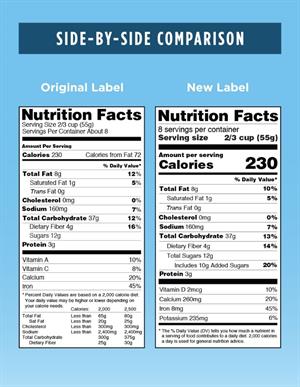When the typical shopper strolls -- or rushes -- down the aisles in their supermarket, they may notice a myriad of colors and labels on packaged items. The color of packaging may lead some to think a certain food item is healthy because the packaging is green, or perhaps they are attracted to a fun snack in a red or orange package. Package claims like “low fat,” “plant-based,” “organic,” and “non-GMO” abound.
Claims and labels on the front of packages may provide useful information for consumers, such as those pertaining to nutrients (e.g., low sodium) or implied nutrient content claims that have strict regulatory definitions (e.g., health). However, they are also sometimes used by brands as a marketing tool to attract attention. On the other hand, the information in black and white-- the Nutrition Facts panel and list of ingredients -- offers facts and figures, not advertising.
The Nutrition Facts panel, usually on the side or back of the package or container, offers valuable information for the nutrition and health professional, and for the shopper - if they take the time to look at it. The new Nutrition Facts label,1 which can already be seen on products, has expanded features:
- The amount of calories per serving is in a larger font.
- A more realistic serving size is included to reflect what people actually eat and drink. 2
- A line for added sugar (in grams) is listed under carbohydrates.
- The vitamins and minerals section is expanded. In addition to iron and calcium, vitamin D and potassium are now required to be listed, whereas vitamins A and C are no longer required.
Shoppers may pay attention to different parts of the food label. Those with high blood pressure on a sodium restricted diet would be encouraged to notice the amount of sodium per serving. For someone with diabetes, they would typically check the amount of carbohydrates per serving. Overall, shoppers are increasingly looking at the amount of protein and added sugar.
Above all, shoppers should pay attention to the most important line on the Nutrition Facts panel-- serving size, as that amount influences all other information.
